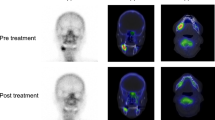Abstract
Objective
This study was conducted to investigate the clinical utility of quantitative bone single-photon computed tomography-computed tomography (SPECT/CT) for detection and classification for medication-related osteonecrosis of the jaw (MRONJ).
Materials and methods
Fifty-nine patients (69 lesions) clinically diagnosed as MRONJ by four specialists of Japanese Society of Oral Surgery according to the AAOMS diagnostic criteria and who underwent bone SPECT/CT were enrolled. One reader determined standard uptake values (SUVs), including maximum (SUVmax), peak (SUVpeak), and mean (SUVmean), as well as metabolic bone volume (MBV), representing total volume above threshold, and total bone uptake (TBU), calculated as MBV × SUVmean, using the GI-BONE software package. One-way repeated-measures analysis of variance and subsequent post hoc analysis were employed to compare quantitative values between clinical stages. To check reproducibility of values, another reader calculated these quantitative values.
Results
Mean SUVmax values for stage 0 (n = 21), 1 (n = 13), 2 (n = 25), and 3 (n = 10) were 5.82 ± 3.20, 5.46 ± 3.79, 8.16 ± 3.93, and 10.57 ± 8.43, respectively, while values for MBV were 9.52 ± 6.33, 11.36 ± 7.32, 12.4 ± 8.21, and 17.84 ± 16.94, respectively, and for TBU were 40.60 ± 46.97, 53.70 ± 77.26, 62.37 ± 42.91, and 102.01 ± 74.52, respectively. There were significant differences for SUVmax, SUVpeak, and SUVmean between clinical stages (p = 0.024, p = 0.027, p = 0.039, respectively). Subsequent post hoc analysis showed that SUVmax and SUVpeak of stage 3 were significantly higher than those of stage 0 (p = 0.046, 0.045, respectively). MBV and TBU showed a tendency to increase with increased stage, though differences between stages were not significant (p = 0.15, p = 0.053, respectively). Little differences of mean SUVmax, SUVpeak, SUVmean, MBV, and TBU between two readers were observed (− 3.10%, − 0.26%, − 4.24%%, 0.69%, and − 3.42%, respectively). The intraclass correlation coefficients (ICCs) of SUVmax, SUVpeak, SUVmean, MBV, and TBU were 0.985, 0.990, 0.980, 0.994, and 0.994, respectively (almost perfect for all values).
Conclusion
As objective and reliable indicators, SUVmax and SUVpeak derived from quantitative bone SPECT/CT results are useful for detection of early status disease, as well as staging in MRONJ patients.







Similar content being viewed by others
References
Kishimoto H, Noguchi K, Takaoka K. Novel insight into the management of bisphosphonate-related osteonecrosis of the jaw (BRONJ). Jpn Dent Sci Rev. 2019;55:95–102.
Marx RE. Pamidronate (Aredia) and zoledronate (Zometa) induced avascular necrosis of the jaws: a growing epidemic. J Oral Maxillofac Surg. 2003;61:1115–7.
Aghaloo TL, Felsenfeld AL, Tetradis S. Osteonecrosis of the jaw in a patient on denosumab. J Oral Maxillofac Surg. 2010;68:959–63.
Cosman F, Crittenden DB, Adachi JD, Binkley N, Czerwinski E, Ferrari S, et al. Romosozumab treatment in postmenopausal women with osteoporosis. N Engl J Med. 2016;375:1532–43.
Ruggiero SL, Dodson TB, Fantasia J, Goodday R, Aghaloo T, Mehrotra B, O’Ryan F, American Association of Oral and Maxillofacial Surgeons. American association of oral and maxillofacial surgeons position paper on medication-related osteonecrosisof the jaw-2014 update. J Oral Maxillofac Surg. 2014;72:1938–56.
Miksad RA, Lai KC, Dodson TB, Woo SB, Treister NS, Akinyemi O, et al. Quality of life implications of bisphosphonate-associated osteonecrosis of the jaw. Oncologist. 2011;16:121–32.
Tenore G, Mohsen A, Rossi AF, Palaia G, Rocchetti F, Cassoni A, et al. Does medication-related osteonecrosis of the jaw influence the quality of life of cancer patients? Biomedicines. 2020;8:95.
Khan AA, Morrison A, Hanley DA, Felsenberg D, McCauley LK, O’Ryan F, et al. Diagnosis and management of osteonecrosis of the jaw: a systematic review and international consensus. J Bone Miner Res. 2015;30:3–23.
O’Ryan FS, Khoury S, Liao W, Han MM, Hui RL, Baer D, et al. Intravenous bisphosphonate-related osteonecrosis of the jaw: bone scintigraphy as an early indicator. J Oral Maxillofac Surg. 2009;67:1363–72.
Assaf AT, Zrnc TA, Remus CC, Adam G, Zustin J, Heiland M, et al. Intraindividual comparison of preoperative (99m)Tc-MDP SPECT/CT and intraoperative and histopathological findings in patients with bisphosphonate- or denosumab-related osteonecrosis of the jaw. J Craniomaxillofac Surg. 2015;43:1461–9.
Miyashita H, Shiba H, Kawana H, Nakahara T. Clinical utility of three-dimensional SPECT/CT imaging as a guide for the resection of medication-related osteonecrosis of the jaw. Int J Oral Maxillofac Surg. 2015;44:1106–9.
Zeintl J, Vija AH, Yahil A, Hornegger J, Kuwert T. Quantitative accuracy of clinical 99mTc SPECT/CT using ordered-subset expectation maximization with 3-dimensional resolution recovery, attenuation, and scatter correction. J Nucl Med. 2010;51:921–8.
Bailey DL, Willowson KP. An evidencebased review of quantitative SPECT imaging and potential clinical applications. J Nucl Med. 2013;54:83–9.
Kitajima K, Noguchi K, Moridera K, Kishimoto H, Tsuchitani T, Takahashi Y, et al. Usefulness of quantitative bone SPECT/CT for evaluating treatment response in a patient with mandibular osteomyelitis. Case Rep Oncol. 2021;14:820–5.
Okui T, Kobayashi Y, Tsujimoto M, Satoh K, Toyama H, Matsuo K. Quantitative evaluation of anti-resorptive agent-related osteonecrosis of the jaw using bone single photon emission computed tomography in clinical settings: relationship between clinical stage and imaging. Ann Nucl Med. 2020;34:620–8.
Ogawa R, Ogura I. Analysis of medication-related osteonecrosis of the jaw with bone SPECT/CT: relationship between patient characteristics and maximum standardized uptake value. Dentomaxillofac Radiol. 2021;50:20200516.
Funding
Part of this research was supported by the 2019 Hyogo College of Medicine Faculty Research Grant.
Author information
Authors and Affiliations
Corresponding author
Ethics declarations
Conflict of interest
The authors declare that they have no conflict of interest.
Ethical approval
This was conducted as a retrospective study following approval from the Ethics Committee of Hyogo College of Medicine, Japan (No. 3144).
Research involving human and animal participants
We clearly state that human participants have the approval of an appropriate named ethics committee including Helsinki declaration.
Additional information
Publisher's Note
Springer Nature remains neutral with regard to jurisdictional claims in published maps and institutional affiliations.
About this article
Cite this article
Moridera, K., Kitajima, K., Yoshikawa, K. et al. Usefulness of quantitative bone SPECT/CT for medication-related osteonecrosis of the jaw in clinical settings. Jpn J Radiol 40, 492–499 (2022). https://doi.org/10.1007/s11604-021-01226-1
Received:
Accepted:
Published:
Issue Date:
DOI: https://doi.org/10.1007/s11604-021-01226-1




